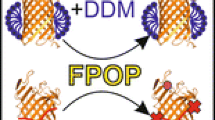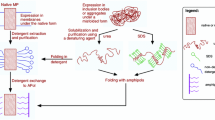Abstract
Amphipathic polymers called amphipols provide a valuable alternative to detergents for keeping integral membrane proteins soluble in aqueous buffers. Here, we characterize spatial contacts of amphipol A8-35 with membrane proteins from two architectural classes: The 8-stranded β-barrel outer membrane protein OmpX and the α-helical protein bacteriorhodopsin. OmpX is well structured in A8-35, with its barrel adopting a fold closely similar to that in dihexanoylphosphocholine micelles. The accessibility of A8-35-trapped OmpX by a water-soluble paramagnetic molecule is highly similar to that in detergent micelles and resembles the accessibility in the natural membrane. For the α-helical protein bacteriorhodopsin, previously shown to keep its fold and function in amphipols, NMR data show that the imidazole protons of a polyhistidine tag at the N-terminus of the protein are exchange protected in the presence of detergent and lipid bilayer nanodiscs, but not in amphipols, indicating the absence of an interaction in the latter case. Overall, A8-35 exhibits protein interaction properties somewhat different from detergents and lipid bilayer nanodiscs, while maintaining the structure of solubilized integral membrane proteins.




Similar content being viewed by others
Abbreviations
- A8-35:
-
Polyacrylate-based amphipol, carrying ~25 % octylamide chains, ~40 % isopropyl-amide ones, and ~35 % free carboxylates
- APol:
-
Amphipol
- BR:
-
Bacteriorhodopsin
- DDM:
-
n-Dodecyl-β-d-maltopyranoside
- DHPC:
-
1,2-Dihexanoyl-sn-glycero-3-phosphocholine
- DMPC:
-
1,2-Dimyristoyl-sn-glycero-3-phosphocholine
- Gd(DOTA)− = DOTAREM:
-
A gadolinium ion chelated with 1,4,7,10-tetraazocyclododecane-N,N′,N″,N′″-tetraacetic acid
- OmpX:
-
Outer membrane protein X
References
Althoff T, Mills DJ, Popot J-L, Kühlbrandt W (2011) Assembly of electron transport chain components in bovine mitochondrial supercomplex I1III2IV1. EMBO J 30:4652–4664
Bayburt TH, Sligar SG (2010) Membrane protein assembly into nanodiscs. FEBS Lett 584:1721–1727
Bayburt TH, Grinkova YV, Sligar SG (2002) Self-assembly of discoidal phospholipid bilayer nanoparticles with membrane scaffold proteins. Nano Lett 2:853–856
Caravan P, Ellison JJ, McMurry TJ, Lauffer RB (1999) Gadolinium(III) chelates as MRI contrast agents: structure, dynamics, and applications. Chem Rev 99:2293–2352
Catoire LJ, Zoonens M, van Heijenoort C, Giusti F, Popot J-L, Guittet E (2009) Inter- and intramolecular contacts in a membrane protein/surfactant complex observed by heteronuclear dipole-to-dipole cross-relaxation. J Magn Res 197:91–95
Catoire LJ, Zoonens M, van Heijenoort C, Giusti F, Guittet E, Popot J-L (2010) Solution NMR mapping of water-accessible residues in the transmembrane β-barrel of OmpX. Eur Biophys J 39:623–630
Champeil P, Menguy T, Tribet C, Popot J-L, le Maire M (2000) Interaction of amphipols with the sarcoplasmic reticulum Ca2+-ATPase. J Biol Chem 275:18623–18637
Dahmane T, Rappaport F, Popot J-L (2013) Amphipol-assisted folding of bacteriorhodopsin in the presence and absence of lipids. Functional consequences. Eur Biophys J 42:85–101
Elter, S, Raschle, T, Arens, S, Gelev, V, Etzkorn, M, Wagner, G (2014). The use of amphipols for NMR structural characterization of 7-TM proteins. (submitted to same issue of J. Membr. Biol.)
Etzkorn M, Raschle T, Hagn F, Gelev V, Rice AJ, Walz T, Wagner G (2013) Cell-free expressed bacteriorhodopsin in different soluble membrane mimetics: biophysical properties and NMR accessibility. Structure 21:394–401
Fernández C, Hilty C, Wider G, Guntert P, Wüthrich K (2004) NMR structure of the integral membrane protein OmpX. J Mol Biol 336:1211–1221
Gohon Y, Pavlov G, Timmins P, Tribet C, Popot J-L, Ebel C (2004) Partial specific volume and solvent interactions of amphipol A8-35. Anal Biochem 334:318–334
Gohon Y, Giusti F, Prata C, Charvolin D, Timmins P, Ebel C, Tribet C, Popot J-L (2006) Well-defined nanoparticles formed by hydrophobic assembly of a short and polydisperse random terpolymer, amphipol A8-35. Langmuir 22:1281–1290
Gohon Y, Dahmane T, Ruigrok R, Schuck P, Charvolin D, Rappaport F, Timmins P, Engelman DM, Tribet C, Popot J-L, Ebel C (2008) Bacteriorhodopsin/amphipol complexes: structural and functional properties. Biophys J 94:3523–3537
Hilty C, Wider G, Fernández C, Wüthrich K (2004) Membrane protein–lipid interactions in mixed micelles studied by NMR spectroscopy with the use of paramagnetic reagents. ChemBioChem 5:467–473
Huynh, KW, Cohen, MR, Moiseenkova-Bell, VY (2014). Application of amphipols for structure–functional analysis of TRP channels. Submitted for publication to the same issue of J. Membr. Biol
Lee D, Hilty C, Wider G, Wüthrich K (2006) Effective rotational correlation times of proteins from NMR relaxation interference. J Magn Reson 178:72–76
Liao M, Cao E, Julius D, Cheng Y (2013) Structure of the TRPV1 ion channel determined by electron cryo-microscopy. Nature 504:107–112
Martinez KL, Gohon Y, Corringer P-J, Tribet C, Mérola F, Changeux J-P, Popot J-L (2002) Allosteric transitions of Torpedo acetylcholine receptor in lipids, detergent and amphipols: molecular interactions vs. physical constraints. FEBS Lett 528:251–256
Pautsch A, Vogt J, Model K, Siebold C, Schulz GE (1999) Strategy for membrane protein crystallization exemplified with OmpA and OmpX. Proteins 34:167–172
Perlmutter, JD, Popot, J-L, Sachs, JN (2014). Molecular dynamics simulations of a membrane protein/amphipol complex. (submitted to same issue of J. Membr. Biol.)
Picard M, Dahmane T, Garrigos M, Gauron C, Giusti F, le Maire M, Popot J-L, Champeil P (2006) Protective and inhibitory effects of various types of amphipols on the Ca2+-ATPase from sarcoplasmic reticulum: a comparative study. Biochemistry 45:1861–1869
Planchard, N, Point, E, Dahmane, T, Giusti, F, Renault, M, Le Bon, C, Durand, G, Milon, A, Guittet, E, Zoonens, M, Popot, J-L, Catoire, LJ (2014). The use of amphipols for solution NMR studies of membrane proteins: advantages and limitations as compared to other solubilizing media. (submitted to same issue of J. Membr. Biol.)
Plesniak LA, Mahalakshmi R, Rypien C, Yang Y, Racic J, Marassi FM (2011) Expression, refolding, and initial structural characterization of the Y. pestis Ail outer membrane protein in lipids. Biochim Biophys Acta 1808:482–489
Popot J-L (2010) Amphipols, nanodiscs, and fluorinated surfactants: three non-conventional approaches to studying membrane proteins in aqueous solutions. Annu Rev Biochem 79:737–775
Popot J-L, Althoff T, Bagnard D, Banères J-L, Bazzacco P, Billon-Denis E, Catoire LJ, Champeil P, Charvolin D, Cocco MJ, Crémel G, Dahmane T, de la Maza LM, Ebel C, Gabel F, Giusti F, Gohon Y, Goormaghtigh E, Guittet E, Kleinschmidt JH, Kühlbrandt W, Le Bon C, Martinez KL, Picard M, Pucci B, Rappaport F, Sachs JN, Tribet C, van Heijenoort C, Wien F, Zito F, Zoonens M (2011) Amphipols from A to Z. Annu Rev Biophys 40:379–408
Raschle T, Hiller S, Etzkorn M, Wagner G (2010) Nonmicellar systems for solution NMR spectroscopy of membrane proteins. Curr Opin Struct Biol 20:471–479
Tribet C, Audebert R, Popot J-L (1996) Amphipols: polymers that keep membrane proteins soluble in aqueous solutions. Proc Natl Acad Sci USA 93:15047–15050
Vogt J, Schulz GE (1999) The structure of the outer membrane protein OmpX from Escherichia coli reveals possible mechanisms of virulence. Structure 7:1301–1309
Zhou HX, Cross TA (2013) Influences of membrane mimetic environments on membrane protein structures. Annu Rev Biophys 42:361–392
Zoonens M, Popot J-L (2014). Amphipols for each season. (to be submitted to same issue of J. Membr. Biol.)
Zoonens M, Catoire LJ, Giusti F, Popot J-L (2005) NMR study of a membrane protein in detergent-free aqueous solution. Proc Natl Acad Sci USA 102:8893–8898
Acknowledgments
We thank Profs. Kurt Wüthrich and Gerhard Wagner for their kind support of materials and instrument time, Prof. Gerhard Wider for helpful discussions and F. Giusti (UMR 7099) for the synthesis of deuterated A8-35. This work was supported by grants from the German Academic Exchange Service (DAAD) and the DFG (ET 103/2-1) to M.E., as well as the Swiss National Science Foundation (Grant PP00P3_128419) and the European Research Council (FP7 contract MOMP 281764) to S.H., by the French Centre National de la Recherche Scientifique, Université Paris-7, and grants from the CNRS interdisciplinary program Physique et Chimie du Vivant, from the EU (BIO4-CT98-0269), from the Human Frontier Science Program Organization (Grant RG00223/2000-M), and from E.U. Specific Targeted Research Project IMPS (Innovative tools for membrane protein structural proteomics) to J.L.P.
Author information
Authors and Affiliations
Corresponding author
Rights and permissions
About this article
Cite this article
Etzkorn, M., Zoonens, M., Catoire, L.J. et al. How Amphipols Embed Membrane Proteins: Global Solvent Accessibility and Interaction with a Flexible Protein Terminus. J Membrane Biol 247, 965–970 (2014). https://doi.org/10.1007/s00232-014-9657-9
Received:
Accepted:
Published:
Issue Date:
DOI: https://doi.org/10.1007/s00232-014-9657-9




